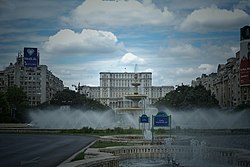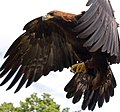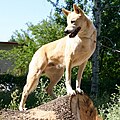Pavulturilor
Democratic Republic of Pavulturilor
| |
|---|---|
Coat of arms
| |
Motto:
| |
| Location of Pavulturilor in Ecros. Location of Pavulturilor in Ecros. | |
| Location of Pavulturilor In Terraconserva. Location of Pavulturilor In Terraconserva. | |
| Capital and largest city | Dăbuza |
| Official language | Pavulturilori Hebrew |
| Ethnic groups |
|
| Religion |
|
| Demonym(s) |
|
| Government | Stratocratic Republic |
| Shimon Levi | |
| Meir Cohen | |
| Legislature | Pavulturilori Parliment |
| Establishment | |
| 1293-1293 | |
| 1296 | |
| 1300-1453 | |
| 1749 - 1755 | |
| 1779 - 1801 | |
• Establishment of the Kingdom of Pavulturilor | 1801 |
| 1859-1860 | |
| 1920-1923 | |
| 1945 - 1948 | |
| 1961 | |
| 1968-1998 | |
| 25 May 2008 – 28 November 2008 | |
| 12 – 19 December 2009 | |
| 12 – 13 August 2012 | |
| 28 August 2012 - 11 November 2022 | |
| 1 January 2023 | |
| Area | |
• Total | 3,820,207 km2 (1,474,990 sq mi) (6) |
| Population | |
• 2023 estimate | 80 million |
| GDP (nominal) | 2023 estimate |
• Total | ₵790,000,000,000 ₪2,765,000,000,000a |
• Per capita | ₵9,875 ₪34,562.5b |
| HDI (2021) | 0.772 high · 17 |
| Currency | ₪Shekel (PS) |
| Time zone | Pavulturilori timezones |
| Date format | dd/mm/yyyy, AC/ADc |
| Driving side | right |
| Calling code | +32 |
Pavulturilor, officially the Democratic Republic of Pavulturilor (Pavulturilori: Republica Democratică Pavulturilor, Hebrew:הרפובליקה הדמוקרטית של פבולטורילור (Ha'Republika Ha'Democratit Shel Pavulturilor)), is a nation located in the south of Ecros. It is bordered by Terranihil to the north, New Illyricum to the northwest, Dansin to the southwest, Sconia to the southeast, the Caelean Sea to the east, and the Romanyan Sea to the south. Pavultorilor's capital and largest city is Dăbuza, located at the eastern part of the country along the coast of the Caelean Sea. As of 2023, Pavulturilor has the population of 64 million, of which most are ethnic Pavulturilorians, with the second largest minority being Arabs.
As of 1 January 2023, the current Government is comprised of the Party for National Integrity with it's head, Shimon Levi acting as the country's newly incumberment President.
History[edit]
WIP
Ancient times[edit]
Pre-Romanyan civilization[edit]
The area known today as Pavulturilor was once home to many different tribes and kingdoms, most notable of which, the Judeans along the Pavulturilori Caelean coast in Judea and Shomron, the Dacians in Dacia and Walakhians in Walakhia, as well as Arabs in the Pavulturilori parts of the Arabian Penninsula.
Romanyan Era[edit]
Upon expansion of the Romanyan Empire, all the civilizations which inhabited old Pavulturilor fell one by one into being either client states of full provinces of the empire, resistance to the Romanyan Empire varied with some populations, mainly Dacians and Judeans being the most notbale with the Dacian-Romanyan Wars and the Judea Rebellions being prime examples, while Walakhians and others were more accepting of the Romanyan rule.
Middle Ages[edit]
Early Middle Ages[edit]
With the collapce of the Romanyan Empire the first entity in the are of Pavulturilor to seize the oppurtunity would the Dacians who would establish the Duchy of Dacia in 617, not long after them, rebelling against the Umayyad Caliphate, the Judeans would establish the Kingdom of Greater Judea, these two instances would result in a chain of events, that by the late-900's, would effectivly split the Abbasid Caliphate to control the southeastern parts of the Negba Desert and parts of modern-day Terranihil and Majocco.
High Middle Ages[edit]
In the early 1000's through to the early 1100's the Kingdom of Greater Judea would carry out a series of wars in attempt to gain control over the Negba Desert, those attempts would see varying degrees of success, with the last of the Negba Wars ending in stalemate, it would seek to expand westwards in the Western Judean Campaign, and successfuly conquer the Yardeni Emirate, and the Edomite Confederacy, and by the mid-late 1200's, would reach a border with the Grand Duchy of Dacia.
Meanwhile, the Duchy of Dacia, along with the newly established Kingdom of Wallakhia and Fiefdom of Vastulvaniva would wage their own wars against the caliphate. In 1187 a territorial dispute between the Duchy of Dacia and the Kingdom of Illyricum would result in the First Călăneasan War, which would end in 1193 with a Dacian victory, which would see the formation of the Grand Duchy of Dacia. In 1221, due to disputes between local lords, The Grand Duchy of Dacia would issue an ultimatum to the Kingdom of Walakhia, which would be rejected by king Ovidiu Teofil Albu, the rejection would result in the joint Dacian-Vastulvanian Conquest of Walakhia, the war would last 13 years until in 1234 it would finally conquer Walakhia, this conquest however, would be short-lived as the region was plauged by dissobidiance, bandits and highwaymen, tension would eventually culminate in the Walakhi Rebellion of 1241, it would end in 1244 with Walakhian independence and War between the re-established Wallakhia and Fiefdom of Vastulvania, which would end in total conquest of Vastulvania by the Wallakhians.
This defeat would also result in the mutiny of House Vasile, which would go on to declare the Kingdom of Northern Dacia and the Dacian Civil War of 1250, after 16 years, the mutiny would be crushed, the House of Vasile and their colaborators slaughtered and Gabi Dumitru Vasile publically executed. Ten years later, in 1276, the Grand Duchy would go at a second attempt to conquer Walakhia, starting the Dacian-Wallakhi War, which would end in Dacian victory in 1280.
In 1293, Envoies from the Kingdom of Greater Judea to the Grand Duchy of Dacia arrived at the doorstep of Grand Duchess Marta Ramona Solomon, with a preposal to end the bloodshed on the borders with the annexation of the Grand Duchy into the folds of Greater Judea, the Envoies would be executed and their heads would be sent back along with a mocking letter to King Alram Melekh III that would suggest the annexation of Greater Judea to the Grand Duchy, sparking the Judeo-Dacian War, the war would last 3 yeaars until 1296, where both sides reached an agreement that instead would unify the two realms, the unified realm would be called Judeo-Dacian Empire, named after the meeting place for the signing of the pact, which was swarming with eagles.
Late Middle Ages[edit]
WIP
Early-modern Era[edit]
Following the Folkon War, the Judeo-Dacian Empire's many ethnicities have began to develope a nationalist sentiment, while the empire did its best to crack down on it, such actions have recived mixed results, while some ethnic groups had relinquished such ideals, others would only be emboldened, such as in the 1774 Damesek Affair, where a group of Dameseki Arabs revolted against the city's imperial governor, while the revolt failed, it would serve as an omen for the extreme violence that would engulf almost all realms of the empire just 5 years later.
On 8 May 1779, the newly coronated Emperor, Ezra Melekh IX, who would due to a Deliberate misinterpertation, would be seen by Patriarch Rafael Dorin Vlad as a blasphemer. The Patriarch would proceed to rally the local christian population to a crusade against imperial rule. Hearing of the crusade, the Mufti of the Strechia, an Island realm dominated by Sunni Muslim population, would call for a holy war of his own against the empire, declaring the Strechian Intifada, taking control of the port city of Rovillia, Strechian forces would soon take control of the entire island, save for the Ma'oz Ha'Shollet fort, which would be besieged for almost the entirty of the war.
The situation would take a turn for the worse for the Empire when in early 1780 the Imperial Governor of the Greater Dubătemir Realm would declare the independence of Dubătemir as a City-State. This rebellion however would not be as long as the others, lasting only 6 years until the Sack of Dubătemir in 1786. Inspired by the actions in Dubătemir, Arabs from Damesek would go on and attempt another take-over of the city in 1783. This time successful, they would go on to ally with some of the local tribes in the Negba Desert to try and establish a Greater Dameseki State, however, not all tribes would submit to the Dameseki agenda, some choosing to stay loyal to the empire, have waged irregular war on rebel forces until and following the arrival of Imperial forces. And in 1789, the Negba War would also come to a close.
As the Empire managed to reletivly stabalise the situation, more forces could be allocated to the more serious rebellions, which by now were full-scale wars of attrition, defined by the siege in Strechia, and back-and-forth fights over cities in the Dacian theater. practically brute forcing both of the rebellions to submission, by early 1801 the situation was resolved, however not without consequences. Being seen as the "main problem" groups, both the Wallakhis and the Strechians were prosecuted post-war in a series of violent and brutal reprisals which eventually culminated in the Wallakhi and Strechian genocides, accumilating a total of around 400,000 victims combined, the drastic demographic change would impact the newly established Kingdom of Pavulturilor, with some scholars even claiming it to be the cause of Pavulturilor's reletively low population count in comperrission to it's landmass.
Modern Era[edit]
WIP
Etymology[edit]
Pavulturilor's Name originate from the Eagle Land Pact of 1296, the official document hat scemented the unification of the Kingdom of Greater Judea and the Grand Duchy of Dacia following the end of the Judeo-Dacian War.
Geography[edit]
Pavulturilor has the area of 3820207 km2 (1474990 mi2), making it the sixth largest nation in all of Terraconserva, and the third largest in Ecros.
The Khermon mountain range runs along the country's eastern and forms the border with New Illyricum, while its border with Terranihil consists of the Andaluzian Mountains and the Alaian Steppes. The country's southeast consists of the vast Negba desert, the country's west is dominated by either lush forests or vast steppes, with the Duben River streching from the Pavulturilori-New Illyrian border all the way to the Romanyan Sea. While the east is either arid and mountainous, or vast grasslands, with the most notable exception being the area of the Dăbuza Commissariate, which is comprised of sourthern alaia, Judea, Shomron, and the Gilboah regions, which are also predominently grasslands and mountains.
Climate[edit]
Pavulturilor's climate is vast and diverse, ranging from arid to tropical and even snowy in some areas, the jungles are lush and get as much as 7,000mm of rain per year, tepmperatures in pavulturilor can range from 30°C to 20°C in most areas in the summer, as much as 45°C in the north of the country, and as little as 5°C in the mountains. While in the winter temperatures are normally between 20°C to 12°C throughout most of the country, with the mountains being able to reach -20°C, with the lowest temperature recorded being -34°C in 1988.
Wildlife[edit]
The wildlife of Pavulturilor is composed of many species, including lions, leoperds, tigers, bears, wolves, foxes, eagles, vultures, falcons, hawks, gazells, cows, camels, and many more. Pavulturilor's national animal is the Pavulturilori Eagle, which is considered a protected animal by the government despite not being endangered, poaching any protected animal in Pavulturilor is punishable by death.
-
The Veșnicie sângeroasă flower, a protected species, also used as a symbol of Pavulturilori memorial day.
-
An Iris Vestul-Yardaniei, commonly sighted in the mountains of the Shomron region.
-
A Glebionis coronaria, a flower species native to Southern Ecros.
-
A Lilium candidum, a flower species native to Southern Ecros.
-
An Anemone coronaria, a flower species native to Southern Ecros, also Pavulturilor's national flower.
-
The Ecrosian stone-curlew, common throught all of Ecros.
-
The Pavulturilori Eagle, Pavulturilor's national animal.
-
The Barkan bleak, a Freshwater species of fish endemic to Pavulturilor.
-
The Nubian Ibex, a desert-dweeling goat species commonly found in the Negba desert.
-
The Judean Sheperd, a dog species endemic to Pavulturilor.
Demographics[edit]
(WIP)
Politics[edit]
Internal[edit]
Pavulturilori General Elections[edit]

The Current government system of pavulturilor is a general voting franchise, meaning that every vote is counted, of the 1,100 seats of the Pavulturilori Parliament, 882 seats are dominated by the PIN Party, which's ideology is Cohenism, with it's party head, Shimon Levi also serving as the country's first elected President.
Commissaraites of Pavulturilor[edit]
Pavulturilor is Devided into 6 Commisariates, those are Călănasea, Dăbuza, Strechia, Zărnecuta, and Zamăești.
Each High Commissar is elected by the Marshal of Pavulturilor to govern their respective commissariate.
External[edit]
Pavulturilor is a member state of CODECO, along with that, it good ties to some nations in Ostlandet Including but not limited to Akvarelusus, Baltanla, New Gandor, and Paleocacher.
It takes an offensive stance against all Communist Countries, alongside with most nations in ACES save for Eleutherios
Military[edit]
The National Armed Forces of Pavulturilor are the main fighting force of Pavulturilor, it is devided into 7 branches, Army, Navy, Air Force, Stratigic Missile Force, Special Forces, Commissariate of Political Correctness and the SNS, which is the intelligance service, every male and female who reach the age of 18 are conscripted for a 3 year period (unless a physical/pcycological condition prevents them from service), due to the 10 year long military rule, the country's military in exeptional condition and deemed by some as "dispropotionally Large" reletive to the country's population, the annual military budget takes 8% of the country's total annual budget in 2023.
in early 2023 Pavulturilori legislature has legalized the security contracting industry, this is seen by many as a return to the mercenary era in all but name, with companies such as the Black League PMC, which claims it's inheritance from the Templar Task Force MG, are seen as a "Shadow Army" of the government, such claims are often ignored by government officials.
Economy[edit]
(WIP) The Pavulturilori Economy is a mostly open market with minimal state interferance, it is laregly reliant on exporting Salt and Arms, as of today, Pavulturilor is one of the laregest arms exporters on Terraconserva, with many world-wide costumers.
Culture[edit]
(WIP)
Law and Order[edit]
Pavulturilori Law enforcement are divided into 3 main bodies, the National Police, the Commissars, and occassionally, the SNS
Police[edit]
The main law enforcing body in Pavulturilor, the National Police is responisble for most major crime-fighting in Pavulturilor.
Commissars[edit]
The Commissariate of Political Correctness is the Gandarmarie formation of Pavulturilor.

SNS[edit]
The SNS, also known as the National Security Service has 2 main divisions, homeland defense, and foreign activities, homeland defense in the main body in charge of countering terror attacks and organizations
Notes[edit]
- Articles with short description
- Use dmy dates from May 2022
- Articles with invalid date parameter in template
- Use Jackian from May 2022
- All LCNWiki articles written in Jackian
- Pages with broken file links
- Articles with hatnote templates targeting a nonexistent page
- Pages using country topics with unknown parameters
- Pavulturilor
- Terraconserva
- Countries of Terraconserva
- Current CODECO member states










